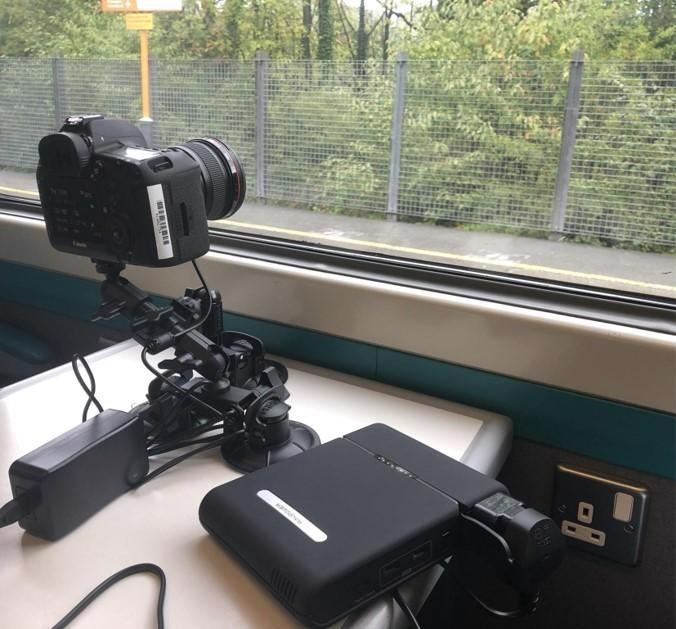Artificial intelligence (AI) trials have shown that lineside vegetation may be monitored securely, inexpensively, rapidly, and at scale by identifying species of trees and other plants from images obtained by on-train cameras.
 On-train cameras took thousands of images of lineside vegetation, from which AI software then subsequently identified tree and other plant species. Image Credit: Keen AI.
On-train cameras took thousands of images of lineside vegetation, from which AI software then subsequently identified tree and other plant species. Image Credit: Keen AI.
Due to safety considerations, the size of Britain’s 20,000-mile rail network, and the number of specialist surveyors required, monitoring flora and fauna on the side of a railway track to promote improved management of lineside ecosystems is exceedingly challenging.
However, Network Rail has been collaborating with the UK Centre for Ecology and Hydrology (UKCEH) and technology firm Keen AI to create creative ways to remotely monitor biodiversity. Researchers have shown that AI can recognize invading species by their tracks, as well as native trees that may be threatened by diseases like ash dieback.
As part of Network Rail’s aim to achieve biodiversity net gain on its property by 2035, this information would enable railway staff to take necessary action to better manage lineside vegetation.
UKCEH and Keen AI have developed AI software that can recognize ash trees, and also Japanese knotweed, Himalayan Balsam, and the toxic plant Ragwort, which is a source of complaints to Network Rail by its neighbors every year.
Scientists are currently working on camera technology that can take clear photos of vegetation on a high-speed train, and researchers have already completed two successful trials: one between Birmingham and Aberystwyth, and another between Weymouth and Moreton in Dorset.
The trials demonstrated that we will be able to monitor lineside vegetation safely, cheaply, quickly and at scale. Our equipment was able to take thousands of clear images from a train traveling at up to 80mph, and our AI software can identify ash and other species to a high level of accuracy.
Dr. Tom August, Computational Ecologist, UK Centre for Ecology and Hydrology
The work on the railway, according to Amjad Karim, chief executive of Keen AI, builds on a different, prior initiative, financed by Innovate UK, to picture and classify roadside vegetation.
Network Rail spends £200 million each year on vegetation management; in order to keep the network operational. The aim of our work is to give staff at Network Rail the tools they need to safely and accurately identify where action may be required. We’ve been pushing the boundaries of what is possible when it comes to the speed of the camera, quality of images and size of the system, all while keeping it flexible and low-cost.
Amjad Karim, Chief Executive, Keen AI
The team plans to improve the system in the following months, increasing the pace of image collection and guaranteeing that each one is correctly mapped to the location where it was captured, even at speeds of up to 100 mph. This ensures that the great majority of trees and plants along a path are documented.
Another method in which AI could be used to monitor lineside biodiversity is by recognizing animal species from sound recordings or images collected by distant monitoring stations, which would eliminate the need for on-the-ground surveyors.
The UKCEH has tested the use of biodiversity monitoring stations to capture bird song and bat noises, which were reliably identified using current AI software. AI software for classifying animal species from pictures is still under development across the world.
The AI effort, according to Network Rail, will complement its sustainability plan, which outlines major changes to the way the company manages its property to find a better balance between operating a safe, dependable railway and assisting nature.
With 52,000 hectares of land to manage and seven million people living close to our railway, monitoring, maintaining and improving the biodiversity of our land effectively is a monumental and vital task which requires forward-thinking solutions.
Dr. Neil Strong, Biodiversity Strategy Manager, Network Rail
“The partnership with UKCEH and Keen-AI has shown that using AI can be a safer, quicker, more cost-effective and more comprehensive way of monitoring land surrounding the railway, and we’re excited to see how this technology can be developed further to help us realize our ultimate goal of achieving a biodiversity net gain by 2035,” Dr. Strong concludes.
UKCEH is also assisting Network Rail in measuring lineside biodiversity through the use of high-resolution photography from satellites and aircraft to create a full national map of all lineside habitats, which is an innovative and safe method. Its researchers then looked at records of species in comparable environments in each location to see what animals and plants may be present.